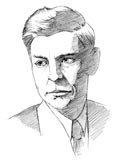Erich von Däniken
Swiss writer Erich von Däniken (b. 1935) popularized the notion of paleocontact—prehistoric alien visits to Earth—in the late 1960s and early '70s. In popular "nonfiction" books such as Chariots of the Gods? (1968) and Gods from Outer Space (1970), von Däniken propagated an idea that has proved irresistible to later science fiction writers and directors: kind extraterrestrial guides visited Earth in ancient times and helped establish human civilizations. Inexplicable artifacts such as Stonehenge and the famed Easter Island statues are said to prove his thesis. Mistaken understanding of the aliens' true nature—they were gods or angels—provided the basis of many religious ideas. Von Däniken was instantly controversial, and his evidence was repeatedly questioned by experts. But judging by the number of times his basic themes have been rehashed, including in the most recent installment of Indiana Jones, his ideas have a mythic appeal beyond their merits.
Olaf Stapledon

Olaf Stapledon (1886-1950), a philosopher by training, wrote science fiction in the 1930s and 1940s that some consider the most masterful ever penned. In Star Maker (1937), this Englishman placed humanity on a cosmic evolutionary journey that ends in near divinity. In Last and First Men (1930), he portrayed the possibility of genetic engineering. Odd John (1935) told the story of a post-human vanguard of highly evolved, inordinately intelligent children. Stapledon believed we needed a new mythology for the dawning technological age. At times, he even cast himself as a mystic with an urgent spiritual message. His influence on science fiction writers such as Sir Arthur C. Clarke, as well as scientists such as Freeman Dyson, was profound.
Ray Kurzweil

Inventor Ray Kurzweil (b. 1948) argues that we are approaching the historical moment when technology will not simply advance incrementally, but explode exponentially. The "Singularity," as Kurzweil has dubbed this breakthrough moment, will be a scientific apocalypse. The boundless possibilities of technology directed by enlightened humanity will be suddenly revealed. But The Singularity Is Near: When Humans Transcend Biology (2005) moves well beyond musings about the rapid pace of technological developments. It claims humanity will move into space, information will multiply geometrically, human minds will blend with machine intelligence to keep pace, and every atom of the universe will eventually revel in newfound purpose. Our destiny is to awaken the cosmos to consciousness. Death itself yields to science. Kurzweil's vision squares with that of earlier transhumanists such as biologist Sir Julian Sorell Huxley. Freeing our thinking from present biological limitations is "an essentially spiritual undertaking."
Freeman Dyson

Respected physicist Freeman Dyson (b. 1923) acknowledges Stapledon's impact on his thinking. Indeed, Dyson's imagined future of humans' limitless evolutionary advancement and technological development is much like Stapledon's. Dyson's speculative proposals—most notably, creating a vast sphere to capture a star's energy to fuel our future—have sometimes shown up in science fiction narratives. In Imagined Worlds (1997), Dyson speculates that humanity will continue to evolve, perhaps into separate groups, including ones that are part machine. Disagreements may arise, but space is vast enough to accommodate us all.
Lee M. Silver

Controversial Princeton biologist Lee M. Silver (b. 1952) imagines a human future in which present biology is not destiny. What we are now is not what we shall become. Boundaries separating species are largely linguistic and moral constructions. Restrictions on human enhancement research—including cloning—reflect the lingering effects of ancient religious taboos. The word eugenics may scare people, but he believes it points to a hopeful use of science: human enhancement. Perhaps a new term is needed: reprogenetics, the blending of reproductive and genetic technologies. We already alter our bodies technologically in a variety of ways, and there is no good reason to obstruct the arrival of new enhancement technologies. So his argument goes. In Remaking Eden: How Genetic Engineering and Cloning Will Transform the American Family (1998) and Challenging Nature: The Clash of Science and Spirituality at the New Frontiers of Life (2006), Silver argues for radical openness to a new humanity. We must take charge of our own evolution. His scientific projections complement Stapledon's mythic vision of an ever-changing, ever-progressing human race.
Copyright © 2009 Christianity Today. Click for reprint information.
Related Elsewhere:
This sidebar was part of Christianity Today's cover story on "Sci-Fi's Brave New World."













